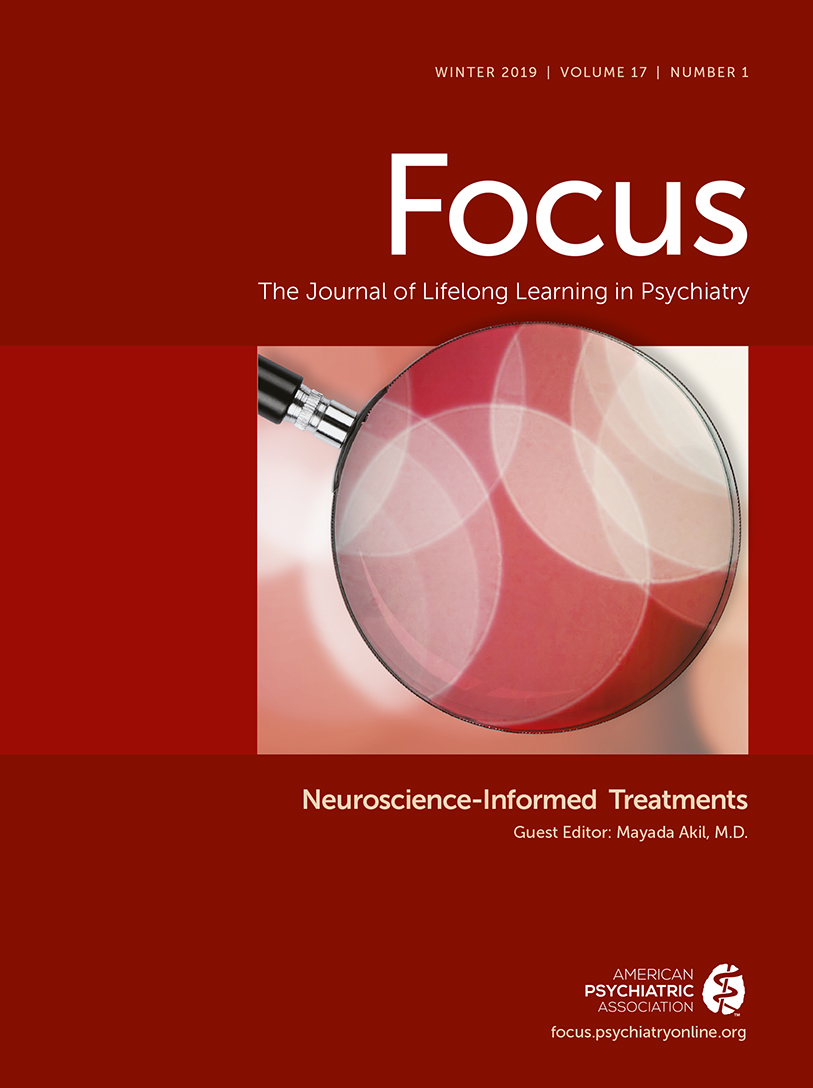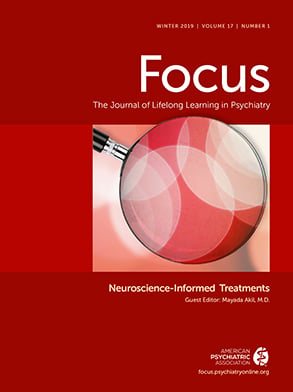What training do psychiatrists need to become informed and engaged with the new neuroscience-based treatments?
To answer this question, it is important to put it into context, as the answer is not simply a list of topic areas. Now is arguably the most exciting time to be working in the field of psychiatry. Since the beginning of recorded history, mental or psychiatric illnesses (or diseases) have been regarded with fear, disbelief, and superstition. These “attributions” have often been accompanied by fantastic descriptions of both the causes and the treatments of these illnesses.
Unfortunately, there exists a false separation of psychiatric illnesses from “physical illnesses,” despite conclusive proof that all of the core psychiatric diseases are associated with changes in brain function, structure, or both. This artificial separateness means that psychiatry remains dogged by stigma, even from our colleagues in other medical specialties.
Psychiatric diseases are more common than almost any other type of disease and among the most serious chronic conditions from which a person can suffer in terms of morbidity and shortened life expectancy. The important World Health Organization (WHO) and World Bank studies and analyses continue to substantiate this point of view (
1,
2).
To truly be trained to understand the future of psychiatry, one has to consider the centrality of the brain and its functioning in the organism as a whole. Furthermore, psychiatrists have to be trained in the anatomy of the brain and the mechanisms by which the brain develops and changes throughout life. Everything that an individual experiences in life, every emotion, every memory, every interaction is processed by this changing organ and is imprinted, to a greater or lesser extent, on it. The human body comprises a system of pumps, filters, glands, conduits, and mechanical systems, the primary aim of which is to support the brain, the organ that controls the system as a whole and the complexity of whose function makes us human.
To separate mind from body is akin to trying to divorce the function of the heart from that of the lungs, since disease in one can lead to malfunction and disease in the other. The brain is as intimately connected with all of the organs of the body as the right ventricle is to the pulmonary arteries. Therefore, it follows, and is clear from the literature, that there are psychiatric sequelae from physical illness, just as there are physical sequalae from psychiatric illness. The key to understanding this complexity is a thorough understanding of clinical neuroscience and its integration with the other facets of psychiatry’s rich tradition and with medicine as a whole (
3).
One of the perceived “problems” with psychiatry has been that the majority of diagnoses and treatments are based on the subjective description of symptoms by the sufferer; therefore, somehow, the diseases are less valid than those for which a rapidly available test can indicate their presence or absence (
4). Nevertheless, one needs to ask, “What would be the consensus on the diagnosis in a male patient describing malaise, nausea, acute right lower quadrant abdominal pain, and a reluctance to move because of the pain?” How is that different from the consensus on “an ill-kempt patient describing low mood and hopelessness over the past month accompanied by a loss of appetite and concentration, and waking at 4 a.m. every morning”? Furthermore, would you tell the patient with acute appendicitis to “pull himself together”? Much of our diagnoses in medicine as a whole are still conducted on the basis of the history from the patient. A physical examination is little different from a mental status examination in its attempt to elicit or observe further symptoms and signs of illness to confirm or refute the diagnosis based on the history. Laboratory procedures are important in medicine, but such procedures need to be integrated with the rest of the information often obtained from the patient and family members.
In all medical specialties, the focus, for the past several centuries has been understanding the physiology of the organs of specialization and how they interact with other organ systems within the human body. This, then, leads to an understanding of the pathophysiology of the diseases treated by a specific specialty and then, naturally, on to pathophysiologically based treatments. The very fact that the brain is several orders of magnitude more complex than any other organ in the body means that psychiatry has lagged behind other medical specialties in understanding the basic physiology of the brain as it relates to the complex behaviors, thoughts, and emotions that form the basis of normal existence and that are also, when the brain is disordered, the outward manifestations of any psychiatric disease process.
It is inevitable that, if the current pace of discovery in clinical neuroscience continues, we will fundamentally change the basis of diagnosing and treating psychiatric illness. The focus in the future will be much more on genetic and neuropathophysiologically determined diagnoses. The treatments we will discover and use will then be based on the identified neuroendophenotypes (
5). This process has been the case with every other medical specialty, and it will be the same for psychiatry.
This has already started with autism spectrum disorders and other developmental delays, where, every year, a proportion of these illnesses is discovered to be secondary to a specific copy number variation or other genetic abnormality (
6). Interestingly, despite these specific abnormalities, there is still variation in the phenotype that speaks to the richness of human diversity and the need for assessments and treatments that integrate all of the possible assessment and interventional approaches.
As part of this evolution, our diagnoses themselves will also change. We have been talking about “the schizophrenias” for decades, and regardless of current diagnoses in treatment trial after treatment trial, we see response rates of 50%–70%. This speaks to the nonspecificity of our clinical diagnoses, but, on a positive note, the consistency of this response rate means that, clinically, we are also likely tapping into something that is likely to be biologically real and amenable to understanding. For instance, already, there are studies, using neuroimaging and machine learning, that can accurately separate groups of youths with mood symptoms into those with bipolar disorder and those without on the basis of the biological data alone (
7). The “schizophrenias” will separate, on the basis of a combination of genetic markers, structural and functional imaging, and electrophysiology, which will allow us to better target both medication and psychosocial interventions, as well as the as-yet untapped potential of techniques such as transcranial direct or alternating current stimulation.
The next 20 years will see key opportunities for further understanding of the causes and treatments of psychiatric illness and, just as important, how this relates to the health of the rest of the human organism and the reciprocal nature of this interaction. In tandem with these discoveries, the study of brain development and physical development through the lifespan will lead to a reconceptualization of health and disease in all organ systems, including the brain.
This reconceptualization is an ongoing process that probably formally started with ensuring that populations had access to clean water to prevent cholera, and it has progressed to the modern day, when people are placed on a medication because the level of cholesterol in their blood is raised above a certain threshold or are advised to reduce their stress levels to prevent a vascular event.
Similarly, further understanding of the ordinary development of the brain; the changes in cortical processing that are associated with various diseases (
8); and how these relate to inflammatory markers (
9), gene expression and regulation (
10), and other indicators of body habitus will lead to preventative interventions (many of them lifestyle or societally based or achieved by helping individuals to reconceptualize their view of themselves in relation to others) and, where these are not possible, to more effective pathophysiologically based treatments, delivered using a wide array of disparate modalities.
Psychiatry and psychiatrists, because we are physicians, will be at the forefront of this endeavor, and we need to train the psychiatrists of the future to be able to integrate these tools and understandings into our already rich skill set.
Thus, as we move forward, psychiatrists in-training now will have to have a better understanding of not only the neuroanatomy of their organ of interest, the brain, but also how different cortical regions are connected to each other at the macro and micro levels, as well as how the integration of these can go wrong in disease and how they may be affected by specific interventions, such as transcranial magnetic stimulation and transcranial cortical stimulation techniques. These will need to be supplemented by a more nuanced understanding of cortical neurochemistry, not only at the neurotransmitter level but also in second messenger systems, neuromodulators, and glial metabolic regulation, to name but three burgeoning areas. Further, we will need to better understand the relationship between diseases primarily of the brain and how they are bidirectionally and pathophysiologically related to diseases of the other organs of the body. This next-generation approach will improve both the understanding of disease and the development of effective treatments that are targeted to individuals and their illnesses.

